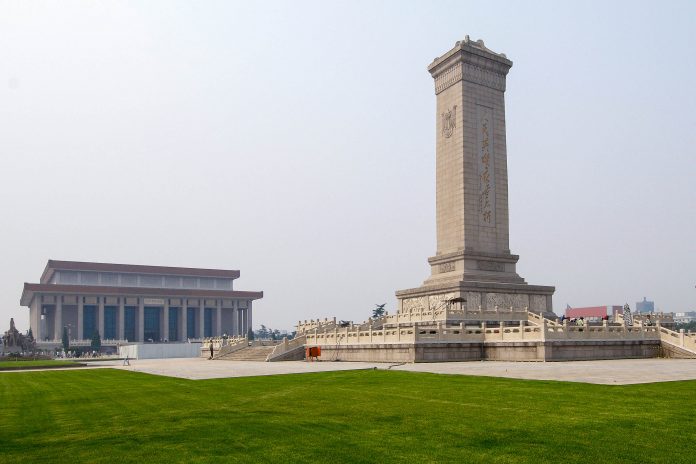Der Platz des himmlischen Friedens in der chinesischen Hauptstadt Peking befindet sich direkt vor dem Kaiserpalast und war bereits Schauplatz zahlreicher geschichtlicher Großereignisse und blutiger Kämpfe wie zum Beispiel die Ausrufung der Volksrepublik China durch Mao Zedong 1949 oder der brutalen Niederschlagung von mehreren hundert Demonstranten 1989.
Der Platz des himmlischen Friedens im Zentrum der chinesischen Stadt Peking, in der Landessprache Tian’anmen Platz, gilt mit seiner Ausdehnung von knapp 40ha Fläche als größter befestigter Platz weltweit. Seinen Namen erhielt er vom eigentlichen Tian’anmen, dem Tor des himmlischen Friedens, hinter dem sich die Verbotene Stadt mit dem Kaiserpalast befindet. Ab 1911 ist der Platz öffentlich zugänglich und wurde immer wieder Schauplatz von politischen Demonstrationen, da er bis zu drei Millionen Menschen Platz bietet.
Entstehung durch „Zufall“
Der Platz des himmlischen Friedens war mehr oder weniger ein architektonischer Unfall, da China traditionell keine großen öffentlichen Versammlungsplätze erlaubte. Doch für den Bau der großen Durchfahrtsstraße „Chang An Jie“ wurde Platz benötigt und so wurden einige Gebäude und Teile der Mauer der Verbotenen Stadt abgerissen.
Nach und nach wurden immer mehr Mauern der Kaiserstadt und Gebäude entfernt, bis nur noch das Haupttor des Kaiserpalastes – das Tor des himmlischen Friedens – bestehen blieb und auch nach etlichen Bränden und Zerstörungen immer wieder aufgebaut wurde.
Rund um den Platz des himmlischen Friedens befinden sich die Große Halle des Volkes im Westen und das Chinesische Nationalmuseum im Osten. Im Süden steht seit 1977 das kolossale Mausoleum von Mao Zedong, in dem sich die mumifizierten sterblichen Überreste des Revolutionärs in einem kristallinen Sarkophag befinden. Maos innere Organe in Formaldehyd eingelegt und sein Körper als Wachsabbildung werden angeblich im Keller aufbewahrt. Dies ist jedoch nicht belegt.
In der Mitte des Tian’anmen steht das 40m hohe „Yingxiong Jinian Bei“ oder Denkmal für die Volkshelden, welches den Männern und Frauen gewidmet ist, die in der Zeit vor dem Kommunismus ihr Leben ließen.
Blutiger Platz des himmlischen Friedens
Der Platz des himmlischen Friedens gelangte aufgrund politischer Kundgebungen und Demonstrationen immer wieder in die Schlagzeilen. Im Mai 1919 fand mit der Bewegung des 4. Mai eine Demonstration von mehreren tausenden Studenten gegen den Versailler Vertrag statt, der ehemalige deutsche Pachtgebiete in der Provinz Shandong nicht an China zurückerstattete.
1949 rief Mao Zedong hier die Volksrepublik China aus. Im Jahr seines Todes 1976 wurde eine Demonstration gegen die Entfernung der Totenkränze des beliebten verstorbenen Ministerpräsidenten Zhou Enlai gewaltsam zerstreut.
Internationale Aufmerksamkeit und Empörung erregte das letztendlich blutige Ende des Aufstandes am 4. Juni 1989, als Pressefreiheit und Demokratie fordernde Demonstranten von der Regierung brutal niedergeschlagen wurden. 300 bis 3.000 Menschen mussten damals ihr Leben lassen.
Im Zuge dieses Aufstandes wurde auch der „Panzermann“ berühmt, der es schaffte, 17 Panzer aufzuhalten, indem er ihnen einfach immer wieder in den Weg sprang und sie nicht vorbeiließ. Heute gilt er als weltweites Symbol des Kriegsgegners. In China wird seine Geschichte zensiert und über den Verbleib des mittlerweile zum Volkshelden avancierten 19jährigen weiß niemand Bescheid.





